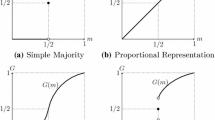Conclusions
With the model of the electoral process described in Section 1, and a social welfare function defined by symmetrically weighting and summing individual utility functions, two factors, in addition to the density of preferences and the form of the weighting function, affect the performance of the electoral process as a mechanism for policy selection. These factors are: (1) the form of the individual loss functions, ∅, (i.e., convexity vs. quasi-convexity), and; (2) the causes of abstentions from voting. If ∅ is strictly convex, a social welfare optimum is achieved except when abstentions are caused by alientation — in which case there is no general solution. If, however, ∅ is quasi-convex, the conditions for achieving a social welfare optimum (presented in Table 2) are more restrictive, requiring at least that w (x) f (x) be unimodal. Finally, if f (x) is a symmetric multimodal density, if ∅ is quasi-convex, and if abstentions are caused by alientation, social welfare optima are achieved only in fortuituous circumstances.
Similar content being viewed by others
References
Davis, O. A., M. J. Hinich, and P. C. Ordeshook, “An Expository Development of a Mathematical Model of the Electoral Process,”American Political Science Review (June, 1970).
Garvey, G., “The Theory of Party Equilibrium,”American Political Science Review (1966).
Hinich, M. J., J. O. Ledyard, and P. C. Ordeshook, Nonvoting and the Existence of Equilibrium Under Majority Rule,Journal of Economic Theory (forthcoming).
Hinich, M. J. and P. C. Ordeshook, “Transitive Social Preference and Majority Rule Equilibrium with Separable Probabilistic Choice Functions,” (Carnegie-Mellon University, 1971).
Ordeshook, P. C., “Pareto Optimality in Electoral Competition,”American Political Science Review (December, 1971)
Author information
Authors and Affiliations
Additional information
This research was supported by a grant from the National Science Foundation.
Rights and permissions
About this article
Cite this article
Hinich, M.J., Ordeshook, P.C. Social welfare and electoral competition in democratic societies. Public Choice 11, 73–87 (1971). https://doi.org/10.1007/BF01726213
Issue Date:
DOI: https://doi.org/10.1007/BF01726213




